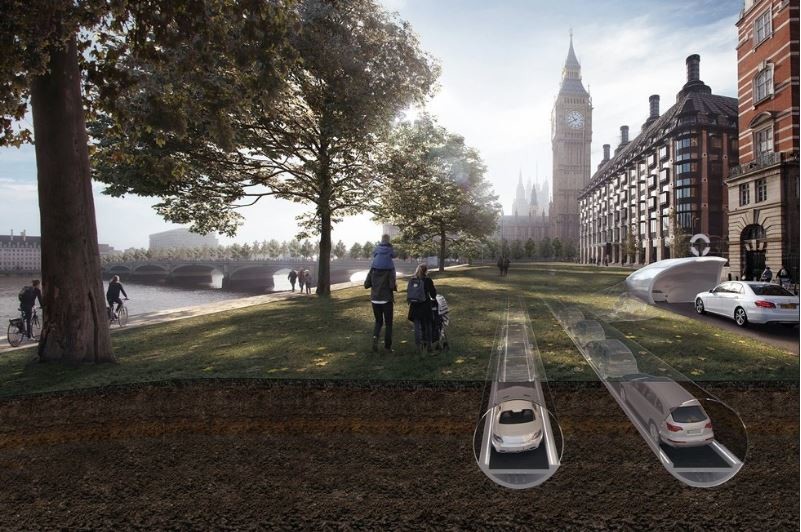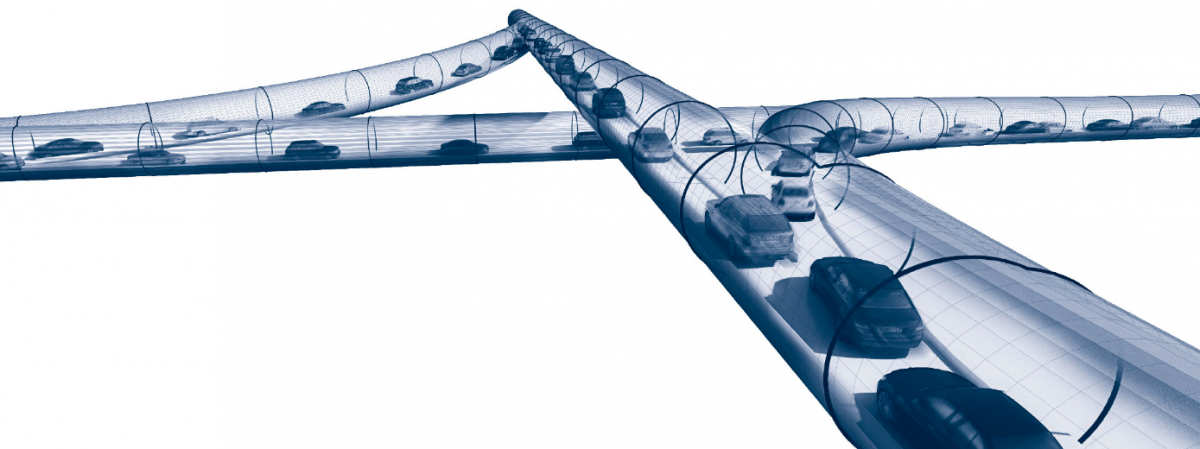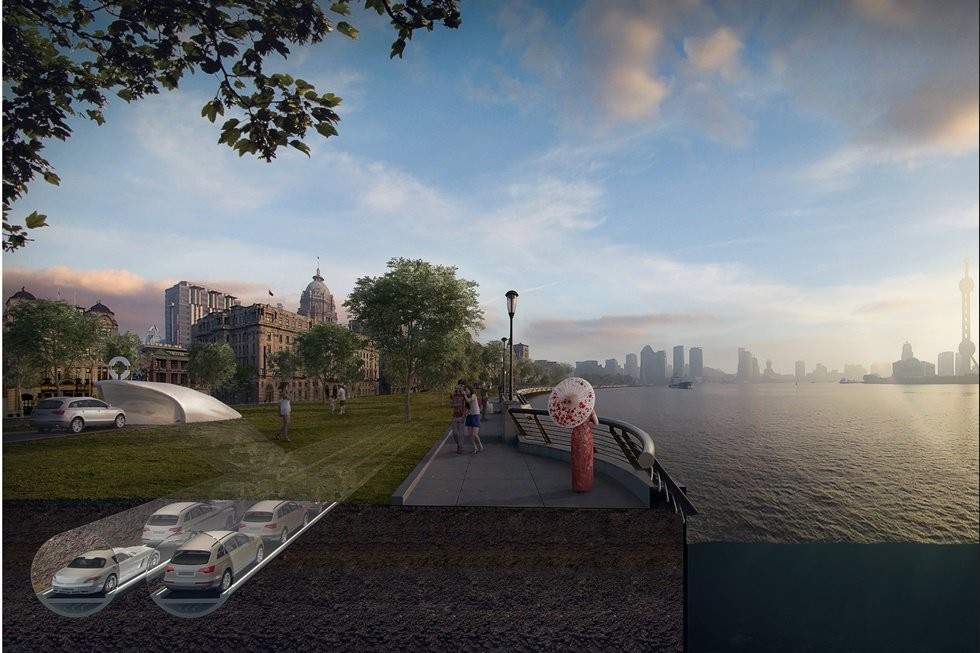Tired of the commute? It might be time to take cars underground
Like many cities, London has a serious problem with gridlock. According to Eurostat’s Urban Europe report, the city has the worst congestion in Europe - an average commuter there spends 101 hours in traffic every year.
An obvious solution to this problem would be to upgrade or expand the existing tube, train, and bus networks to be more efficient and far-reaching, so that more locals use mass transit.
But PLP Architecture, a London-based firm, is proposing a more radical idea: moving vehicles underground.
Called the CarTube, the firm’s concept envisions an underground tunnel of automated, conveyor belt-like tracks.
Cars in the tubes would travel a steady speed of 50 mph, so there wouldn’t be stop-and-go traffic, PLP’s director of research, Lars Hesselgren, tells Business Insider. That would allow the network to cut down commute times by up to 75%.
PLP wouldn’t disclose an estimate for the CarTube’s cost, but said it could be built at a fraction of the price of Crossrail, a new high-capacity, 73-mile (117 km) railway that’s under construction in London and the southeastern UK. That project received £14.8 billion ($15.7 billion) in funding.
There are no immediate plans to build the CarTube, but Hesselgren says the firm is talking with a number of partners, including Google, about the concept. He estimates that if the tube were to be built, construction would take less than a decade.
The CarTube would be a 15.5-mile network of tunnels for automobiles. Hesselgren says the system would be located 33 - 98 ft (10- 30 m) below ground level to reduce congestion.
[Image: Business Insider]
The CarTube tunnels would connect to the existing streets. Drivers would just drive onto the tracks, which would slope down to bring them into the tunnel.
[Image: Business Insider]
The system could accommodate 400 cars per hour, he says.
Since the automated tracks would carry riders at a uniform speed, the CarTube could cut down an hour commute to nearly 15 minutes, Hesselgren says. In their proposal, the architects call it “the next best thing to teleportation.”
[Image: Business Insider]
While the team would like to pilot the CarTube in London, they believe it could also be used in other cities that suffer from gridlock, like Shanghai …
[Image: Business Insider]
… and New York. Putting cars underground would also free up more street space for pedestrians, Hesselgren says.
[Image: Business Insider]
While the idea of underground auto tunnels is intriguing and futuristic, however, investing more heavily in the existing tube and bus systems would likely require less time, money, and energy than building a new piece of infrastructure.
As the Guardian also notes, it’s unclear where enough underground space could be found in London amidst the tube tunnels, train tunnels, and sewer systems.
But Hesselgren argues that the CarTube would be quicker and more efficient than the metro. “This technology therefore seems worth investigating since it opens new opportunity for not only faster but vastly more convenient system,” he says. “Extra capacity will certainly be needed by London in the future.”
To prove the concept’s potential value, PLP Architecture even created a simulation of what a CarTube ride might look like:
This article was written by Leanna Garfield, Innovation Reporter, Tech Insider.
This article is published in collaboration with Business Insider.
The views expressed in this article are those of the author alone and not the World Economic Forum.
This article was originally published on the Future of Construction Knowledge Sharing Platform and the WEF Agenda Blog.
[edit] Related articles on Designing Buildings Wiki
- CarTube.
- Hyperloop One.
- Road traffic management.
- Smart motorway.
- Sustainable transport.
- Transit Elevated Bus (TEB).
- Tunnelling.
- Tunnels of the world.
- Types of road and street.
- Underground car park.
- Underground space.
--Future of Construction 14:14, 20 Jun 2017 (BST)
Featured articles and news
RTPI leader to become new CIOB Chief Executive Officer
Dr Victoria Hills MRTPI, FICE to take over after Caroline Gumble’s departure.
Social and affordable housing, a long term plan for delivery
The “Delivering a Decade of Renewal for Social and Affordable Housing” strategy sets out future path.
A change to adoptive architecture
Effects of global weather warming on architectural detailing, material choice and human interaction.
The proposed publicly owned and backed subsidiary of Homes England, to facilitate new homes.
How big is the problem and what can we do to mitigate the effects?
Overheating guidance and tools for building designers
A number of cool guides to help with the heat.
The UK's Modern Industrial Strategy: A 10 year plan
Previous consultation criticism, current key elements and general support with some persisting reservations.
Building Safety Regulator reforms
New roles, new staff and a new fast track service pave the way for a single construction regulator.
Architectural Technologist CPDs and Communications
CIAT CPD… and how you can do it!
Cooling centres and cool spaces
Managing extreme heat in cities by directing the public to places for heat stress relief and water sources.
Winter gardens: A brief history and warm variations
Extending the season with glass in different forms and terms.
Restoring Great Yarmouth's Winter Gardens
Transforming one of the least sustainable constructions imaginable.
Construction Skills Mission Board launch sector drive
Newly formed government and industry collaboration set strategy for recruiting an additional 100,000 construction workers a year.
New Architects Code comes into effect in September 2025
ARB Architects Code of Conduct and Practice available with ongoing consultation regarding guidance.
Welsh Skills Body (Medr) launches ambitious plan
The new skills body brings together funding and regulation of tertiary education and research for the devolved nation.
Paul Gandy FCIOB announced as next CIOB President
Former Tilbury Douglas CEO takes helm.
UK Infrastructure: A 10 Year Strategy. In brief with reactions
With the National Infrastructure and Service Transformation Authority (NISTA).





























